Unit 2-Making a Presentation高级职业英语第三册
Unit-2高级职业英语读写教程3-General-idea-of-the-text
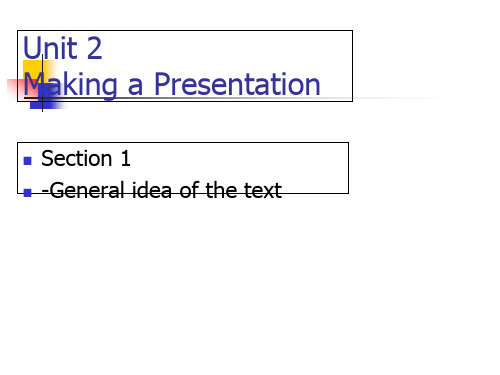
The art of story telling
• What are good stories? • -interesting, clear beginnings • -provocative, engaging content in the middle • -a clear, logical conclusion • -be told in a clear, concise manner
பைடு நூலகம்Unit 2 Making a Presentation
Section 1 -General idea of the text
Making an Effective Presentation
• I. Read the first part of this passage and then have a quick look at the other parts, and tell what it is about in one minute.
will become confident and you will not be so nervous.
• Sentence: When you remove the unknown and reduce anxiety and nervousness, confidence is something that will naturally take the place of your anxiety.
• Sentence: Remember, even if you've been asked to share information, rarely is the mere transfer of information a satisfactory objective from the point of view of the audience.
高级职业英语听说教程unit3MakingaPresentation

1
make preparations for a presentation;
deliever a presentation
Careerclude a presentation.
back
高等教育出版社 高等教育电子音像出版社
Listening and Speaking
LOGO
Section 1 Activity One
1. delivery
2. subject
10. interactive activities
9. Full preparation
8. draw a conclusion
7. brief summary
3. introduction 4. outline
5. interactive 6. audience
Task 1 Listen and Match
next
Section 1 Activity One
b a
c h
f e
back
d g
Section 1 Activity One
Task 2 Listen and write
Listen and complete the general responsibilities of Human Resources Department.
next
Section 1 Activity Two
6. We had better plan a presentation carefully. 7. I’d like to know how to make an effective
presentation about our new products. 8. Leave time for questions near the end of the
unit2- Making a Presentation

back
Section 1 Activity One
Task 1 Listen and Match
next
Section 1 Activity One
b a
c
h
f e
back
d g
Section 1 Activity One
Task 2 Listen and write
Listen and complete the general responsibilities of Human Resources Department.
Section 1 Activity Two
Listen and Repeat
1. Before I start my presentation today, first let me introduce myself. 2. There are certain steps to follow in making an effective presentation. 3. I’d like to conclude my presentation by summing up the points I’ve considered. 4. We often use some body language in making presentations. 5. It is advisable to make use of visual aids in delivering a presentation.
Task 1 Listen and Repeat Task 2 Listen and Complete Task 3 Role Playing Task 4 Just Do It
Task 5 Challenge Yourself
高级职业英语第三册 读写课程 unit2-making a presentation

Reading and Writing Unit Two
LOGO
Unit 2 Making a Presentation
Career Skill Description
1 2 3 4
Getting Things Ready
Things to Do
Things to Write
academic satisfactory purpose formulate take the place of motivate point of view delivery be based on logic conclusion
Hale Waihona Puke backRead and Think
Making an Effective Presentation Surveys continually show that people fear public speaking more than death, but so much of academic and corporate life requires public speaking that it cannot be avoided. This passage gives tips on how to make an effective presentation in public. Start with the end in mind. Before you even open up a presentation, sit down and really think about it. What is the real purpose of your talk? What does the audience expect? In your opinion, what are the most important parts of
高中英语外研版(2019)必修第三册Unit2 Making a difference-Sta

Contribution: rode a tricycle to make money for poor children; donated 350000 yuan in 18 years; helped more than 300 students complete their studies
Personal qualities: selfless, hardworking, generous, kind-hearted
waiter or waitress is
3) ________ a classmate with their studies
4) ________ someone who looks lost if they________ directions
5) _______________________in the home.
make a great contribution to mankind
As a senior high school student, what can we do to
make a differenceO? ne small act can make a big difference.
be a volunteer When we study at When we are at
Contribution: took good care of the sick; found the modern nursing; declined the death rate
Personal qualities: patient, caring, sympathetic(有 同情心的), considerate(体贴的), responsible
练习答案unit2 高级职业英语读写3

Focus on Grammar
Task 2 8. She told them a story in class this morning. (一般疑
problem? ❖ 依你的看法,最好的职业是什么? ❖In your opinion, what is the most ideal career?
Section 2 Things to Do
❖Task 6 ❖6. Surveys show that .../ fear sth.1 more than sth.2 ❖ 调查显示大多数女人害怕发胖比什么都厉害。 ❖Surveys show that most women fear becoming fat
5. He doesn’t go to school by bus. (反意疑问句)
He doesn’t go to school by bus, does he?
6. She does a lot of washing at home. (特殊疑问句) What does she do at home?
问句) Did she tell them a story in class this morning? 9. You must be polite to the old people. (祈使句) Be polite to the old people. 10. Liu Hua went to see a film and a doctor just now.
明是不够的。 ❖Even if you are clever, rarely is mere cleverness
高级职业英语(第二版)听说教程3多媒体课件2unit 2

Unit 2 Project Management
Section 1 Before-class Activities: Getting Things Ready
Activity 1 Speak Out
Task 1 Talk to two students to create a wanted ad for a project manager and complete the table below.
6. stimulate 7. intervention 8. implement 9. passionate 10 negotiation .
11. under pressure
12
work under pressure
.
13 a competent project manager
.
14 produce quality outputs
Activity 1 Listen and Repeat
Task 1 Listen to the following words and then repeat them after the recording.
premier a. 第一的,首要的 competent a. 有能力的,胜任的 energetic a. 精力充沛的;积极的 passionate a. 充满激情的 persistent a. 持久的;执著的 stimulate v. 刺激;激励 output n. 产出,输出 monitor v. 监控 stakeholder n. 股东;利益相关者
Unit 2 Project Management
Section 1 Before-class Activities: Getting Things Ready Task 2 Listen to the following sentences and then repeat them after the recording. 1. Creating a clear project plan is of great importance for project success.
中专英语第三册unit2教案

★In that case, there is nothing you can do ______ than wait.A. moreB. otherC. betterD. any答案为B。
一、“other than”的含义1.other than = except, but, apart from “除……以外”There is nobody here other than me. 这里除了我以外没有别人。
Someone other than your brother should be appointed manager. 应当任命一个除了兄弟之外的人当经理。
2. other than = besides “除……以外,还……”English is now spoken in many countries other than England. 除英国外,其他许多国家都讲英语。
There were three people at the meeting other than Mr Day. 除戴先生以外,还有三个人参加了会议。
3.other than = not, instead of, rather than “不、非、而不是”I borrowed some books other than novels. 我借了几本书,都不是小说书。
4.other than = in any other way than “用除此以外别的方式”You can’t get there other than by swimming.除了游过去之外,你没有别的方法到达那儿。
二、“other than”的结构1.other than + 名词/代词The presence of elements other than iron greatly affects the physical properties of steel.铁以外的其他元素的存在极大地影响着钢的性能。
高级职业英语(第二版)听说教程3多媒体课件2unit 4

.
6. publisher 7.technological8. enormous 9. societal 10 conform .
11. quality control
12
on-site inspection
.
13 during the manufacturing process
.
14 The finished goods must conform to the specifications.
(on-site) 5. How will the Quality Control Officer perform the final quality control? (random sampling)
Unit 4 Quality Control
Section 2 In-class Activities: Things to Do
technological a. 技术的,科技的 quality control 质量监控 on-site inspection 现场检验 pre-shipment inspection 装运前检验 in-process inspection 制程中检验 first-article inspection 首件检验 volume production 大量生产 ISO (International Organization for Standardization) 国际标准化组织 quality issue 质量问题
and allows any necessary changes to be addressed early on, reducing rework time and costs.
During a pre-shipment inspection, our engineers verify that finished goods conform to the
Unit2-Making a Presentation高级职业英语第三册

back
Activity 2 Fulfill the Following Tasks
Task 1 Complete the outline with the information from the passage. Making Presentations with Pictures Picture presentations: 1. Bar charts, bar graphs, diagrams, and tables offer a simple 2. Bar charts or bar graphs 1) _______________ but meaningful representation of the information lasting impression 3. Bar graphs leave a more 2) _________________ 4. Diagrams are used to demonstrate ideas, facts, plans, concepts, processes, and sequences
next
Activity 2 Fulfill the Following Tasks
6. He __________ to be a reporter after graduating. is eager to 7. China Mobile has set up many iron towers to relay to __________ the signals __________ its users. 8. At the beginning of your presentation, you should try catch the attention to __________________ of your audience.
Unit 2 Making a difference Writing高中英语外研版必修第三册

Main body
Major events(in time order):
—F—r—o—m——1—95—1——to——19—5—5—,—s—h—e—s—tu—d—i—ed——a—t —B—e—ij—in—g——M—e—d—i—ca—l————— College(now Peking University Health Science Centre).
——————————————————————————————————————————
Conclusion
Your opinion on her contribution:
_____S_h__e__s_a_v__e_d__m___a_n__y__p__e_o_p__l_e__s_u_f_f_e__r_i_n_g__f_r__o_m____ malaria.
the story of a person's life written by sb else
the story of a person's life written by sb else
Think about the structure of a biography eye-catching
• Basic information of the person Introduction • His/her biggest achievement
2015: Won the Nobel Prize in Physiology or Medicine for discovering a novel therapy against malaria
《高级职业英语》(第二版)读写教程2—课后练习句子翻译
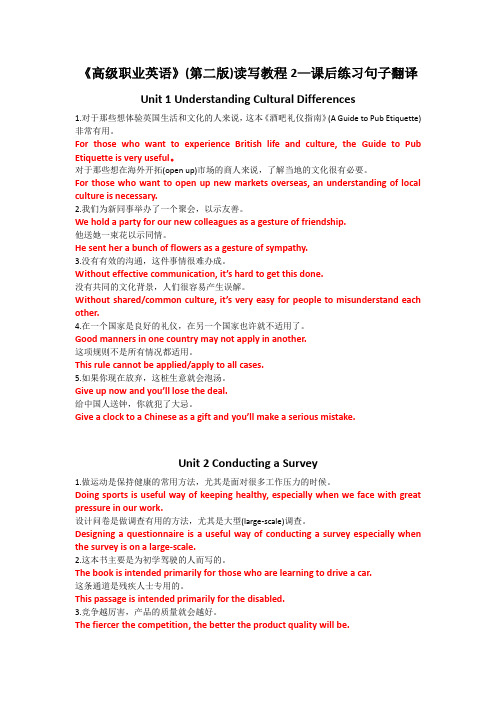
《高级职业英语》(第二版)读写教程2—课后练习句子翻译Unit 1 Understanding Cultural Differences1.对于那些想体验英国生活和文化的人来说,这本《酒吧礼仪指南》(A Guide to Pub Etiquette)非常有用。
For those who want to experience British life and culture, the Guide to Pub Etiquette is very useful。
对于那些想在海外开拓(open up)市场的商人来说,了解当地的文化很有必要。
For those who want to open up new markets overseas, an understanding of local culture is necessary.2.我们为新同事举办了一个聚会,以示友善。
We hold a party for our new colleagues as a gesture of friendship.他送她一束花以示同情。
He sent her a bunch of flowers as a gesture of sympathy.3.没有有效的沟通,这件事情很难办成。
Without effective communicati on, it’s hard to get this done.没有共同的文化背景,人们很容易产生误解。
Without shared/common culture, it’s very eas y for people to misunderstand each other.4.在一个国家是良好的礼仪,在另一个国家也许就不适用了。
Good manners in one country may not apply in another.这项规则不是所有情况都适用。
This rule cannot be applied/apply to all cases.5.如果你现在放弃,这桩生意就会泡汤。
职业高中英语第三册教案Unit 2

Unit2 My DutiesPeriod 1Warning up & listening & speaking ABTeaching aims:Knowledge and ability: students will be able to understand and express their duties and responsibilities.obtain key information during listening activity and use the useful expressions to talk about health and safety rules.Process and Method: Students will learn to be cooperative by group or pair work; use note-taking strategy and repetition strategy; and develop the communicative competence.Emotion, Attitude and Value: Students will be interested in this unit, build confidence in speaking English; consolidate their duties in future work;.Difficult points: To appreciate and understand the proverbs about duties and responsibilities and students can express their own opinions on the topics.Teaching contents: key words and phrasesTeaching proceduresStep1:Lead in : to arise the students’ interest by paying attention to the free questions.Free talkDo you know your duties now?Do you know your responsibilities now?Do you want to know the duties and responsibilities in future work? And how can you know the points?If you can’t answer the last question, let’s find the answer in this unit.Step 2Pre-task: To make the students curious about the duties of the different occupations.1. Read the four information, and try to give the occupation each piece of information.2. Match the information with the occupations.Cashier: He receives cash from customersReceptionist: He greets visitors and directs them to appropriate persons.Waiter: He serves food and drinks to customers.cook: He prepares food, using various cooking methods, i.e., boiling, roasting, baking.Step 3While-task:Listening:1. Extensive listening for main ideaWhich is true about the man?a. He was late for work today.b. He can’t follow what the woman says.c. He has difficulty in doing his tasks.2. Intensive listening for detailsresponsibility →response →responsiblebe responsible for3. Listen again and underline the sentences expressing lack of understanding.I beg your pardon, but what should I do before distributing the reports?Now, wait a second.Speaking:1. Read the expressions for fluency and accuracy.2. Use the expressions they’ve learned to ask for clarification.Grasp the drills of how to ask for clarification.I beg your pardon, but I don’t quite understand.What did you say?Please say again.Are you able to give an example of that point?Could you say that again, please?What?3. Work in pairsRearrange the useful expressions listed above according to polite/ formal, neutral, and least polite/ informal.Polite/ formal: I beg your pardon, but I don’t quite understand.Could you say that again, please?Neutral: Please say again.Are you able to give an example of that point?Least polite/ informal: What did you say? What?Step 4Post-task:Practise: use the useful expression to help you finish the following two situations.Your supervisor has assigned a task to you. But your don’t understand him well.You say:You’re talking with your partner to make a project plan,. You missed a few words he said. Step 5: homeworkRead and recite the conversation.Grasp the useful expressions and use them correctly.Period 2-3Teaching Aims:Knowledge & Ability:(1) The students will be able to understand the dialogue and improve their ability tograsp details in the listening material.(2) The students will be trained in their ability of relaying information.Process & Method:The students will be able to use the note-taking strategy and communicative strategy. Emotion, Attitude & Value:The students will have a positive attitude toward speaking, and will be willing to speak English. Difficult points:Introduce one trendy activity to the partner with the information in listening material. Teaching contents:Some health and safety rules to keep you and other people safe.Step 1Lead in: to introduce the topicAnswer the question:What should you pay attention to as a new employee?What’s the main idea of the tape?(A training course given to new employees.)Step 2:Pre-task:1. Skim over the options: to low the difficulties.2. Key words study :Thoroughly: do something completelyClean up : make… cleanAs soon as possible: as soon as sb. cane.g. Please come here as early as possible tomorrow.Can you give me as much money as possible?Make suree.g. Make sure you clean up as you work.Make sure that you close the door when leaving.Step 3While-task:Listening: To grasp the main idea and to train the ability of capturing details.1. Listen and tick the answer2. Listen and choose correct verbs to complete the rules.(Before listening, make the students read through the fillings.)Words given: leave wash heat report dry1). Wash your hands after you go to the toilet.2). Don’t leave rubbish around.3). Dry the floor, don’t leave it wet.4). Report damaged equipment as soon as possible.5). Heat cooked food to the right temperature.3. Listen again. What should people in the pictures do according to the health and safety rules? (make the students listening carefully and then read the pictures. Try their best to finish thesentences according to the pictures and the tape.)The woman should tie her hair up and wear a hat.The man should wash his hands.The man should dry the floor.Speaking: To train the ability of relaying information1. Teacher present the useful words and phrases as a hint for students2. Introduce one activity in the listening to the partner with the information in listening part. Step 4Post-task: To consolidate and expandSuppose you are manager of the Training Department of a newly opened restaurant. You are giving a speech to the waiters and waitresses. What instructions would you give them? Example: Always welcome customers with a smile.Try to give more after discussing.Make sure you clean up as you work.Be sure to have your pen ready, book open and pad ready.Ask the customer if they have any questions.Gather all information from each guest when taking the order.Identify customers according to position numbers.Always get the cooking temperature for meals.Step 5: homework1. Read the dialogues.2. Grasp the useful expressions and use them freely and correctly.3. Search for the related information of health and safety rules as much as possiblePeriod 4Teaching contents:Learn the new words and expressionsTeaching aims and demands :Enable the students to read the new words correctly and master the usages of them and use them correctly.Be familiar with some words related to computers.Teaching key points:The pronunciations and usages of the new words.Teaching difficult points:The same as the key points.Teaching methods:Reading. PracticingProcedure:Step1:free talkWhat do you do in your spare time?What’s your hobby?Does your family have a computer?How long do you surf the Internet every day?Can you tell us some words about Internet?Step2:giving the new1.Read the new words after me.2.Let them read for a while by themselves.3.Ask some to read and correct their mistakes.4.Read together and correct their mistakes.5.Explain some.beg: I beg your pardon? beg one’s pardon 请原谅,很抱歉Via I will go to Nantong via Rugao. Please send it via e-mail. Employee employ 雇佣employer 雇主replacereplace sth. with sth.I will replace the old desks with the new ones.: take the place ofThe new desks will take the place of the old ones.continue continue to do sth continue doing sthother than 除了Does anybody other than yourself know this?除你本人之外还有别人知道这事吗?She has no close friends other than him.除了他以外她没有好朋友。
高级职业英语立体化系列教材电子教案2 unit 3 unit 3- Listening and Speaking

4. conclude a deal and express wishes for future co-operation
Task 1 Listen and Repeat Task 2 Listen and Complete Task 3 Role Playing Task 4 Just Do It Task 5 Challenge Yourself
Task 1 Listen and Repeat Task 2 Listen and Judge Task 3 Listen and Decide Task 4 Listen and Complete
Hi, everybody! May I have your attention, please? Now, please allow me to show you our latest arrival: the most elegant and delicate __________ of all times! This bag is made of fine, soft genuine leather. Its modern and trendy __________ in design makes it the most attractive and tasteful bag you can ever imagine! It comes in four different __________: brown, white, pink and purple. Today is our promotion day. If you buy any two together, you have __________ off both products. You will have the best choice and best discounts here. Carry a __________ in hand and you are the most graceful lady! Thank you!
外研版新教材高中英语必修第三册:UNIT 2 Making a difference 精品教学课件
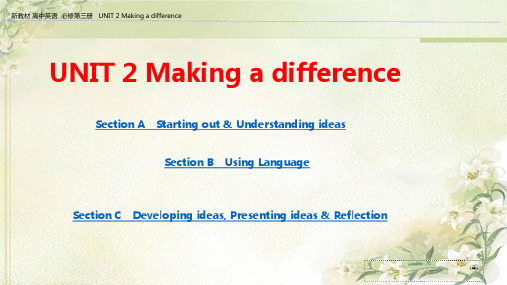
water/food/housing shortage 用水/ 食物 / 住房短缺 There is no shortage of sth. 不缺某物。 ◆归纳拓展
the shortage of money 缺钱
be short of(=lack)缺乏,缺少(强调状态) fall short of 缺乏;达不到;不符合(强调动作) be short for 是……的缩写 / 简称 in short 简言之,总而言之 for short 简称,缩写
the company. (7)_T_h_e_r_e_ ___is___ __n_o___ _s_h_o_r_t_a_g_e ___o_f__(不缺)things to do in big cities.
新教材 高中英语 必修第三册 UNIT 2 Making a difference
词汇四 effective adj. 有效的,产生预期效果的 ◆教材原句 Now tick the solutions that you think are most effective to supply Africa with fresh water. 现在选择你认为非常有效的解决 方案,为非洲提供淡水。 ◆要点必记 take effective measures to do sth. 采取有效措施做某事 have an effect on 对……有影响 ◆单词积累 effect n. 影响,后果 effectively adv. 有效地
He looked across the classroom at the drinking fountain . 他看着教室对面的饮水机。
◆词语辨析
look across,look over 与 look through
Unit2高级职业英语读写教程
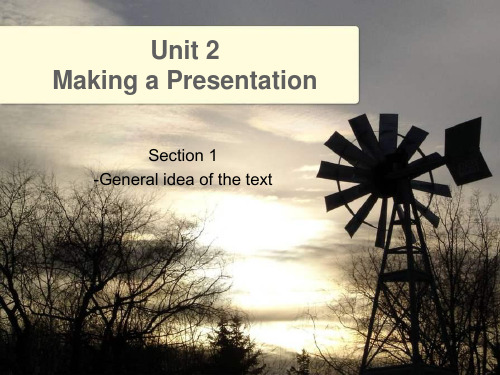
Start with the end in mind
• What does "start with the end in mind" mean? • -You should have a clear idea about what you
are going to get at last, or your purpose / your final goal of your survey before you start it.
• What charts?
Charts
Limiting slices to 4-6, Using colours, or by explod in quantity, Limit bars to 4-8
Charts
To demonstrate trends
• Sentence: Remember, even if you've been asked to share information, rarely is the mere transfer of information a satisfactory objective from the point of view of the audience.
Unit 2 Making a Presentation
Section 1 -General idea of the text
Making an Effective Presentation
• I. Read the first part of this passage and then have a quick look at the other parts, and tell what it is about in one minute.
高级职业英语立体化系列教材电子教案3unit2- Making a Presentation
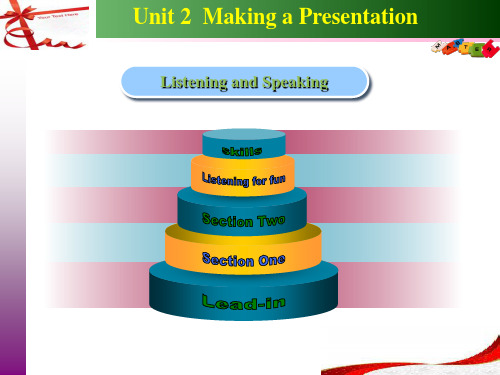
Section 1 Activity Three speak out
Task 2: Prepare a short speech to be presented in class by filling in the blanks with the information from the table above.
back
Activity 1 Task check-ups
Task 1 Listen and Write
Script:
1. introduction 2. delivery 3. interaction 4. outline 5. organization 6. Making sure all the necessary documents are in
Fourth, making use of various skills to make your presentation effective.
Lastly, don’t forget to conclude the presentation by 5) _____s_u_m_m__in_g__u_p_ the points you’ve considered.
Activity 2 Listen and Repeat
Activity 3 Speak Out
Task 1 Listen and Match
Task 2 Listen and Write
Task 1 Talk and complete
Task 2 Prepare a Speech
back
Section 1 Activity One
Task 1 Listen and Repeat Task 2 Listen and Complete Task 3 Role Playing Task 4 Just Do It
高级职业英语听说教程unit 3 Making a Presentation

back
Section 1 Activity Three speak out
Task 1 Talk to two students about the different methods of conducting a survey and complete the table below
back
高等教育出版社 高等教育电子音像出版社
Listening and Speaking Unit 3
LOGO
Unit 2 Making a Presentation
Listening and Speaking
Unit 2 Making a Presentation
In this unit, you will learn to talk about:
next
Activity 1 Task check-ups
Third, organizing the presentation. For example, how many points you will cover in the presentation; how long the presentation will last; etc. Fourth, making use of various skills to make your presentation effective. Lastly, don’t forget to conclude the presentation by summing up the points you’ve considered.
Activity 1 Listen and Look
Activity 2 Listen and Repeat
Activity 3 Speak Out
高级职业英语 unit3
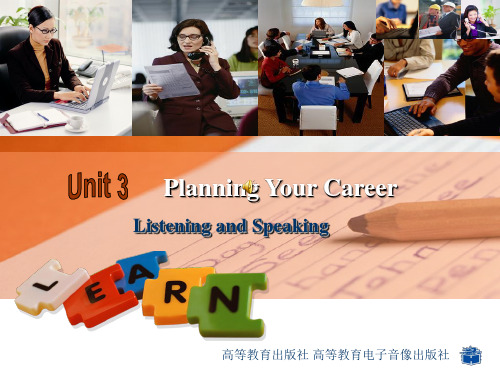
Wang Guang is a student at the Business School of Binhai Vocational College. His major is _______.He hopes to be __________ after graduation because he likes______ and meeting various kinds of people. He plans to open a marketing company of his own after graduation.
Li Ping is from Binhai Engineering College and his major is computer science. He is skilled at computer programming. His dream is to become an engineer in a software company in the future.
and motivation.
Section 1 Activity Two
6. I don’t have much confidence in dealing with people. 7. Hard work is the key to success. 8. I am sure you’ll make a successful career in
2020新教材高中英语Unit2Makingadifference外研版必修第三册课件

Nightingale and the nurses worked around the clock,attending the sick and the wounded,which contributed to the fact that many wounded soldiers survived.The death rate of wounded soldiers fell fhey had to walk ten kilometres to get water. 2.By cleaning windows and doing gardening for his family and
neighbours. 3.By asking for help from his classmates and neighbours and
his dream a reality.
晨读晚诵
重点词汇 重点句式
1.contribution n.贡献 【课文原句】the contribution these people made to society 这些人对社会做的贡献 【词汇精讲】contribution 是名词,意为“捐献;贡献”。还有 “投稿” 的意思,为可数名词,经常用复数形式。 Participating in the contest will be a golden chance for me to show my dancing skills and make some contributions to the class. 参加比赛对我来说是一次难得的展示我舞蹈才能的好机会,并能 对班级做出贡献。 All contributions for the May issue must be received by Friday. 所有要在五月这一期发表的稿件必须在星期五以前寄到。
- 1、下载文档前请自行甄别文档内容的完整性,平台不提供额外的编辑、内容补充、找答案等附加服务。
- 2、"仅部分预览"的文档,不可在线预览部分如存在完整性等问题,可反馈申请退款(可完整预览的文档不适用该条件!)。
- 3、如文档侵犯您的权益,请联系客服反馈,我们会尽快为您处理(人工客服工作时间:9:00-18:30)。
back
Section 2 Things to Do
Question 1
next
Read and Think
Task 1 Test your problem-solving ability.
Find out the most frequently used types of charts.
next
next
Read and Think
Making an Effective Presentation Surveys continually show that people fear public speaking more than death, but so much of academic and corporate life requires public speaking that it cannot be avoided. This passage gives tips on how to make an effective presentation in public. Start with the end in mind. Before you even open up a presentation, sit down and reallythink about it. What is the real purpose of your talk? What does the audience expect? In your opinion, what are the most important parts of
Read and Think
At the very least, you need to answer the basic “W” questions. Who is the audience? What is the purpose of the event? Where is the place? When is it? Content, content, content! No matter how great your delivery, or how professional and beautiful your supporting visuals, if your presentation is not based on solid content, you can not succeed. However, keep it simple. Simplicity takes more forethought and planning on your part because you have to think very hard about what to include
Read and Think
and what can be left out. What is the essence of your message? Appropriate coloured charts may help you make it. The right colour can help persuade and motivate. Here are some examples: Pie charts. Used to show percentages. Limit the slices to 4–6 and contrast the most important slice either with colour or by exploding the slice.
Read and Think
Bar charts. Used to show changes in quantity over time. Best if you limit the bars to 4–8.
Read and Think
Line charts. Used to demonstrate trends. For example, here is a simple line chart showing that our sales have gone up every year. The trend is good. The arrow comes in later to underscore the point: Our future looks good!
How can we know whether a presentation is effective or not?
Question 2
What should we do to make an effective presentare you nervous about it when you made a presentation? How did you deal with it?
Read and Think
your topic for the audience to take away from you? Remember, even if you’ve been asked to share information, rarely is the mere transfer of information a satisfactory objective from the point of view of the audience. Know your audience as well as possible. Before you begin to formulate the content of your presentation, you need to ask yourself many basic questions with an eye to becoming the best possible presenter for that particular audience.
Read and Think
but were relatively effective because the speaker told relevant stories in a clear, concise manner to support his points. Confidence. How to get it? The more you are on top of your material the less nervous you will be. We fear what we do not know. When you remove the unknown and reduce anxiety and nervousness, confidence is something that will naturally take the place of your anxiety. (436 words)
高等教育出版社 高等教育电子音像出版社
Reading and Writing Unit Two
LOGO
Unit 2 Making a Presentation
Career Skill Description
1 2 3 4
Getting Things Ready
Things to Do
Things to Write
next
Section 1 Getting Things Ready
next
Section 1 Getting Things Ready
next
Section 1 Getting Things Ready
next
Section 1 Getting Things Ready
next
Section 1 Getting Things Ready
Activity 2: Read the passage in Section 2 and complete the following paragraph. When making preparations for a presentation, first start with the end in your mind, the mere 1) _____________ of information is not enough transfer for the audience. Secondly, know the audience as well as possible, at the very least, you need to answer the 2) ___________ ―W‖ questions about them. Then basic always keep the content solid and simple, focus on the 3) ___________ of your message. essence
Read and Think
The art of story telling. Good presentations include stories. The best presenters illustrate their points with the use of stories, often personal ones. Stories are easy to remember for your audience. If you want your audience to remember your content, try to find a way to make it relevant and memorable to them. In addition, good stories have interesting, clear beginnings, provocative, engaging content in the middle, and a clear, logical conclusion. I have seen pretty good presentations that had very average delivery and average graphics,
